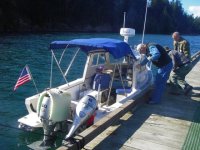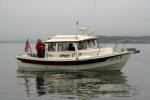Most modern outboards have been engineered to decrease the sound as much as possible. I cannot answer the question about clearance, but I would investigate it by putting some in-expensive soft foam on the inside of the motor and see if it contacts the metal frame of the outboard or flywheel. also one would have to be careful to allow adequate air flow to the intake, and to cool the charging mechanism--which is basically part of the flywheel. You can put some graphite (Key lock spray) on the metal to see where the contacts of the foam are, and then cut down the foam to be sure and clear.
"Sound Down" makes a foam, leaded vinyl/ foam material
Product brochure here Makes a number of products to decrease noise pollution in boats. Basically it is foam, vinyl impregnated with lead and then thinner layer of foam. I have used it to line boxes, which I have put over inboard engines or generators. There is also a carpet underlay material, which is as thin as 5/16" thick. It has the vinyl lead and one side of foam, but if clearance is an issue, I would suspect that you can glue at least the 5/16" material inside of the cowl over the entire structure--and then use the thicker pieces where you can. Before that was available, i used lead sheets, glued or nailed to plywood, and then covered with foam.
Also is there much vibration being transmitted to the hull of the boat, which is resonating. Is the glass in the splash well or any other thin layers of glass adding to the noise by resonation?
Also decoupling the vibration from the transom can help. There are pads made which go under the outboard, and then the motor re-bolted in place--that might also help to de-copule the engine vibration from the hull.
Also it i possible to put one of the bore scope type of cameras either snaked under the cowl or thru the air intake to visualize how much room there is for insertion of foam.
Of course there is always the opposite way, of wearing either noise canceling headphones, or hearing protection as used on the range.




